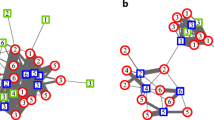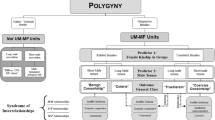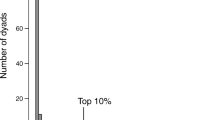Abstract
In recent years, a question has arisen as to whether male and female investigators view natural phenomena in the same way. There could be differences in the research questions asked, the type of data collected, or the way in which a particular datum or observation is interpreted (Fox-Keller, 1985), leading to the possibility that male domination of certain fields leads to a biased view of nature. Lawton, Garska, and Hanks (this volume) have suggested that male-biased narratives have become so pervasive that both male and female researchers are trained to emphasize this perspective, such that some female investigators use a male-centered perspective in their research.
Access this chapter
Tax calculation will be finalised at checkout
Purchases are for personal use only
Preview
Unable to display preview. Download preview PDF.
Similar content being viewed by others
References
Amlaner, C. J. 1983. Sleep patterns of Herring Gulls. Ph.D. dissertation, Oxford University, Oxford, UK.
Annett, C. A. 1982. Foraging behavior of the Leather Seastar, Dermasterias imbricata. Unpublished Master’s thesis, California State University, San Jose.
Annett, C. A. 1987. Proximate mechanisms affecting dietary switches in breeding gulls. Studies in Avian Biology. 10:102.
Annett, C. A. and R. Pierotti. 1984. Laboratory and field investigations of the foraging behavior of the leather seastar, Dermasterias imbricata, in Monterey Bay, Calif. Marine Ecology Progress Series 14:197–206.
Annett, C. A. and R. Pierotti. 1989. Chick hatching as a trigger for dietary switches in Western Gulls. Colonial Waterbirds 12:4–11.
Birkhead, T. and A. P. Møller. 1992. Sperm Competition in Birds: Evolutionary Causes and Consequences. London: Academic Press.
Burger, J. 1984. Pattern, mechanism and adaptive significance of territoriality in Herring Gulls (Larus argentatus). Ornithological Monographs 34:92 pp.
Conover, M. R. and G. L. Hunt, Jr. 1984a. Experimental evidence that female-female pairs in gulls result from a shortage of breeding males. Condor 86:472–476.
Conover, M. R. and G. L. Hunt, Jr. 1984b. Female-female pairing and sex ratio in gulls: An historical perspective. Wilson Bulletin 96:619–625.
Drent, R. 1970. Functional aspects of incubation in Herring Gull. In G. P. Baerends and R. H. Drent (Eds.), The Herring Gull and its Egg pp. 1-132. Behavior Suppl. 17.
Fox, G. A. 1990. Epidemiological and pathobiological evidence of contaminant induced alterations in sexual development in free-living wildlife. In T. Colborn and C. Clement (Eds.), Chemically induced Alterations in Sexual and Functional Development: The Wildlife/Human Connection, pp. 147–150. Adv. Modern Environmental Toxicology, Vol XXI. Princeton, NJ: Princeton Scientific Publishing.
Fox-Keller, E. 1985. Reflections on Gender and Science. New Haven, CT: Yale University Press.
Fox, L. and P. Morrow. 1981. Specialization: species property or local phenomenon. Science 211:887–893.
Fry, D. M., C. K. Toone, S. M. Speich, and R. J. Peard. 1987. Sex ratio skew and breeding patterns of gulls: Demographic and toxicological considerations. Studies in Avian Biology 10:26–43.
Hand, J. L. 1979. Vocal communication of the Western Gull. Unpublished Ph.D. thesis, University of California, Los Angeles.
Hand, J. L. 1981. Sociobiological implications of unusual sexual behaviors of gulls: The genotype/behavioral phenotype problem. Ethology and Sociobiology 2:135–145.
Hand, J. L. 1985. Egalitarian resolution of social conflicts: A study of pair-bonded gulls in nest duty and feeding contexts. Zietschrift fur Tierpsychologie 70:123–147.
Hand, J. L. 1986a. Resolution of social conflicts: Dominance, egalitarianism, spheres of dominance, and game theory. Quarterly Review of Biology 61:201–220.
Hand, J. L. 1986b. Territory defense and associated vocalizations of Western Gulls. Journal of Field Ornithology 57:1–15.
Hunt, G. L. Jr. 1972. Influence of food distribution and human distribution on the reproductive success of herring gulls. Ecology 53:1051–1061.
Hunt, G. L. Jr. and M. W. Hunt. 1977. Female-female pairing in Western Gulls in S. California. Science 196:1466–1467.
Hunt, G. L. Jr., A. L. Newman, M. H. Warner, J. C. Wingfield, and J. Kaiw. 1984. Comparative behavior of male-female and female-female pairs among Western Gulls prior to egg-laying. Condor 86:157–162.
Hunt, G. L. Jr., A. L. Newman, J. C. Wingfield, and D. S. Farner. 1980. Sex ratios of Western Gulls in Southern California. Auk 97:473–479.
Kadlec, J. A. and Drury W. H. 1968. Structure of the New England Herring Gull population. Ecology 49:222–233.
Morris, R. D. 1987. Time-partitioning of clutch and brood care activities in Herring Gulls: A measure of parental quality? Studies in Avian Biology 10:68–74.
Mugaas, J. N. and J. R. King. 1981. Annual variation of daily energy expenditure by the Black-Billed Magpie. Studies in Avian Biology 5:1–78.
Niebuhr, V. 1983. Feeding strategies and incubation behavior of herring gulls. Animal Behaviour 31:708–717.
Noble, G. K. and M. Wurm. 1943. The social behavior of the Laughing Gull. Annual New York Academic Science 45:179–220.
Pierotti, R. 1976. Sex roles, social structure, and the role of the environment in the Western Gull Unpublished Master’s thesis, California State University, Sacramento.
Pierotti, R. 1979. The reproductive behaviour and ecology of the Herring Gull in Newfoundland. Ph.D. dissertation, Dalhousie University, Halifax, Nova Scotia.
Pierotti, R. 1980. Spite and altruism in gulls. American Naturalist 115:290–300.
Pierotti, R. 1981. Male and female parental roles in the Western Gull under different environmental conditions. Auk 98:532–549.
Pierotti, R. 1982. Spite, altruism, and semantics. American Naturalist 119:116–120.
Pierotti, R. 1987. Interactions between gulls and otariid pinnipeds: Competition, commensalism, and cooperation. In J. Burger (Ed.), Seabirds and Other Marine Vertebrates: Commensalism, Competition, and Predation, pp. 213–239. New York: Columbia University Press.
Pierotti, R. 1991. Adoption vs. infanticide: An intergenerational conflict in birds and mammals. American Naturalist 138:1140–1158.
Pierotti, R. and C. A. Annett. 1987. Reproductive consequences of specialization and switching in an ecological generalist. In A. C. Kamil, J. R. Krebs, and H. R. Pulliam (Eds.), Foraging Behavior, pp. 417–442. New York: Plenum Press.
Pierotti, R. and C. A. Annett. 1990. Diet and reproductive performance in seabirds. Bioscience 40:568–574.
Pierotti, R. and C. A. Annett. 1991. Diet choice in the herring gull: Effects of constraints imposed by reproduction and ecology. Ecology 72:319–328.
Pierotti, R. and C. A. Annett. 1994. Patterns of aggression in gulls: Asymmetries and tactics in different roles. Condor 96:590–599.
Pierotti, R. and C. A. Annett. 1995. Western Gull. In A. Poole and F. Gill (Eds.), The Birds of North America, Philadelphia: The Academy of Natural Sciences; Washington DC: American Ornithologist’s Union.
Pierotti, R., D. Brunton, and E. C. Murphy. 1988. Parent-offspring and sibling-sibling recognition in gulls. Animal Behaviour 36:606–608.
Pierotti, R. and E. C. Murphy. 1987. Intergenerational conflicts in gulls. Animal Behaviour 35:435–444.
Power, H. W. 1975. Mountain Bluebirds: Experimental evidence against reciprocal altruism. Science 189:142–143.
Riedman, M. L. 1982. The evolution of alloparental care and adoption in mammals and birds. Quarterly Review of Biology 57:405–435.
Rothstein, S. I. and R. Pierotti. 1988. Distinctions among reciprocal altruism and kin selection, and a model for the initial evolution of helping behavior. Ethology and Sociobiology 9:189–210.
Sibly, R. M. and R. H. McLeery. 1983. The distribution between feeding sites of Herring Gulls breeding at Walney Island. Journal of Animal Ecology 52:51–68.
Spaans, A. L. 1971. The feeding ecology of the herring gull in the northern part of the Netherlands. Ardea 59:75–188.
Taylor, P. W. 1986. Respect for Nature: A Theory of Environmental Ethics. Princeton, NJ: Princeton University Press.
Tinbergen, N. 1960. The Herring Gull’s World, 2nd ed. New York: Basic Books.
Trivers, R. L. 1972. Parental investment and sexual selection. In B. Campbell (Ed.), Sexual Selection and the Descent of Man, Aldine Press.
Trivers, R. L. 1976. Social Evolution. Benjamin Cummings.
Westneat, D. E, P. W. Sherman, and M. L. Morton. 1990. The ecology and evolution of extra-pair copulations in birds. Current Ornithology 7:331–369.
Editor information
Editors and Affiliations
Rights and permissions
Copyright information
© 1997 Springer Science+Business Media Dordrecht
About this chapter
Cite this chapter
Pierotti, R., Annett, C.A., Hand, J.L. (1997). Male and Female Perceptions of Pair-Bond Dynamics: Monogamy in Western Gulls, Larus occidentalis . In: Gowaty, P.A. (eds) Feminism and Evolutionary Biology. Springer, Boston, MA. https://doi.org/10.1007/978-1-4615-5985-6_10
Download citation
DOI: https://doi.org/10.1007/978-1-4615-5985-6_10
Publisher Name: Springer, Boston, MA
Print ISBN: 978-0-412-07361-8
Online ISBN: 978-1-4615-5985-6
eBook Packages: Springer Book Archive




